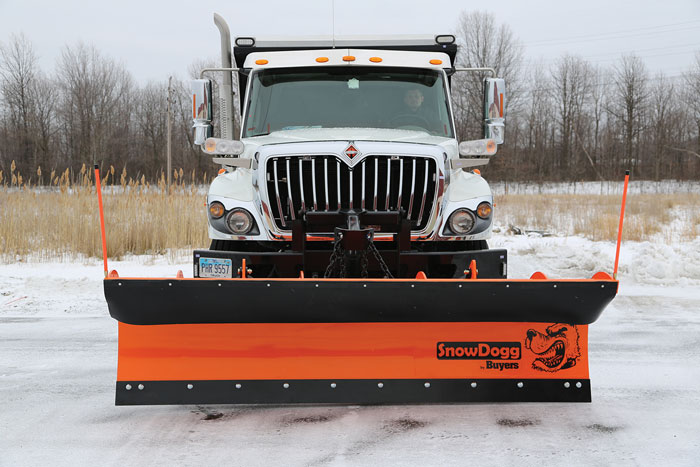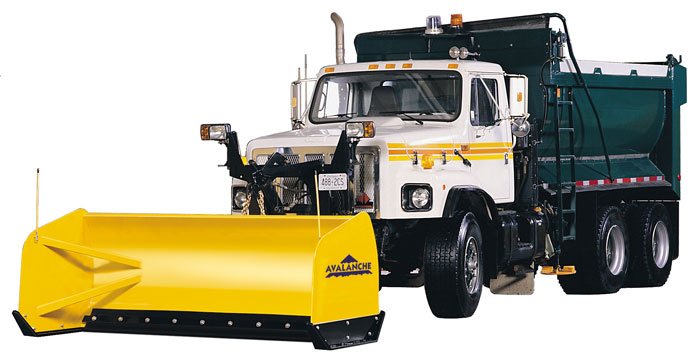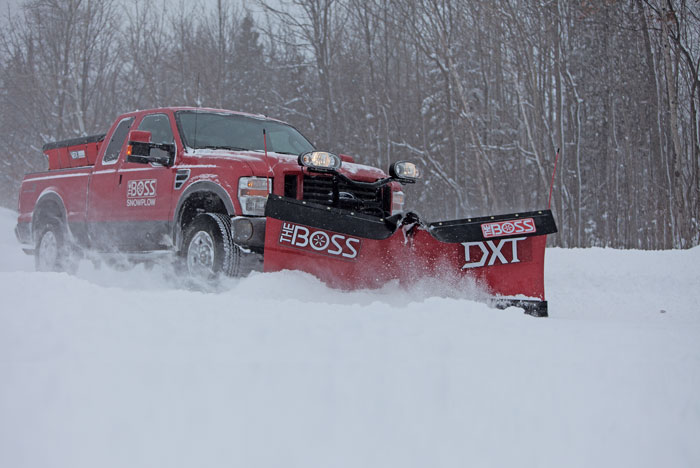Snow Blades
Winter is coming. Not just for Game of Thrones fans, but for the biggest buffs of actual blizzards and ice — the snow removal industry. But not unlike some cold, George R.R. Martin, sword-swinging character, snowplow professionals are their own style of winter warriors. Every season presents new tests of endurance, and keeping a plow business sharp is a constant challenge for every professional plow warrior. Having a good business plan, client list and hard-working crew is essential, but having the right weapons for the battle is paramount as well, which is why picking the perfect snow blade for your truck will be a key ingredient to success.
 “As much as the technology involved might keep changing, one thing hasn’t changed, and that’s the need for a reliable piece of equipment at 3 a.m. in the middle of a snowstorm,” says Scott Moorman, director of engineering at Buyers Products (home to the SnowDogg brand of truck plows). “When we asked in focus groups, real snow professionals didn’t really care about chain lifts, direct lifts, full trip or trip edge. They just wanted something that worked when they needed it to. I think what we’ve seen from our larger end-users are constantly rising expectations for quality and durability. The addition of any new technology to a snowplow requires some serious thought, because if a change doesn’t directly benefit the end-user, what’s the point? As an engineer, I love gadgets, but not hanging off the front of my truck. For that, I want an overbuilt, overdesigned, simple, robust snowplow.”
“As much as the technology involved might keep changing, one thing hasn’t changed, and that’s the need for a reliable piece of equipment at 3 a.m. in the middle of a snowstorm,” says Scott Moorman, director of engineering at Buyers Products (home to the SnowDogg brand of truck plows). “When we asked in focus groups, real snow professionals didn’t really care about chain lifts, direct lifts, full trip or trip edge. They just wanted something that worked when they needed it to. I think what we’ve seen from our larger end-users are constantly rising expectations for quality and durability. The addition of any new technology to a snowplow requires some serious thought, because if a change doesn’t directly benefit the end-user, what’s the point? As an engineer, I love gadgets, but not hanging off the front of my truck. For that, I want an overbuilt, overdesigned, simple, robust snowplow.”
Whether you’re a municipal crew, one-man operation or landscaper-turned-plow-pro, a snow contractor will need a solid plow that fits their business plan — and there are many choices. Step onto the dealer lot of any of these snowplow manufacturers today (THE BOSS Snowplow, Buyers Products, Avalanche, Hiniker, Machinability, Sno-Way, Meyer and a zillion others) and you will discover two main configurations dominate the truck snowplow industry:
Straight Blades — These blades clear snow quickly and easily in environments as narrow as a sidewalk or as expansive as a parking lot, using a heavy-duty blade that is straight. For increased maneuverability, a straight blade can be angled 30 to 45 degrees right or left for exact plowing. Price range is $3,000 to $4,000.
V-Plows — These plows increase the plow pros’ ability to move snow more efficiently and carefully. The V-plow is a multi-position plow (V-position, scoop position, straight position and angle position) that gives your operations more versatility and accuracy. Price range is $4,000 to $6,000.
While V-plows are the most versatile blades, straight blades are still the most popular. V-plows are typically utilized by professionals and cities, while straight blade plows are used by both contractors and consumers. Smaller-size straight blades (popular with homeowners) usually size from 6 to 7 1/2 ft wide and are intended for non-commercial use with down-sized 4-by-4s, SUVs and light 1/2-ton pickups. Conventional straight blade plows are typically sold in 7 1/2-, 8-, 8 1/2-, 9- and 9 1/2-ft sizes, as well as some 10 footers for medium-duty trucks.
“One of the most compelling reasons that a customer chooses a V-plow over a straight blade is the adjustability of the V-plow,” explains Mark Klossner, marketing director with THE BOSS Snowplow. “A V-plow can be maneuvered into any configuration that the conditions call for — scoop, wing, straight blade or V. With this adjustability, a contractor can more precisely move and/or stack snow where he or she wants it — which comes in very handy later in the winter as snow banks and piles get higher and higher and space to put snow is at a premium. In terms of options when considering both, there are a number of considerations. Cost, the plow vehicle’s capability and the desired blade material all come into play. More and more contractors are going from the traditional straight blade to the V-plow — that has been the trend over the past number of years.”
Straight blade plows are the most popular plows, primarily due to cost, ease-of-operation and vehicle applications, but V-plows allow operators to better control the direction of the push. The V-position cuts through heavier snow while the scoop position allows for better cleanup or maneuvering in tight spaces. Typically used in the forward-facing position to capture and move snow when plowing parking lots, streets or other travel ways, the V-plow can also be operated in the V-position to break through deep unplowed snow or as a conventional windrowing plow. V-plows are significantly heavier and more expensive than a straight blade plow, but are more versatile.
Besides straight and V-plows, box plows get attention for specific plow jobs (mostly projects in wide open spaces on very large trucks). Often associated with large wheel loaders clearing snow on massive properties, box plows (also called snow pushers) are designed for some truck applications. Its mission is to quickly move large amounts of snow in a straight line, but box plows are more difficult to transport from site to site because of size.

Unique Plows vs. Poly and Steel
Over the last few years, plow manufacturers have been busy designing new technologies to take plows and pros in new directions. A new plow and plow accessory on the block are power wings. This is a snowplow with extendable wings on its ends, which can allow you to simply stretch your plow length or even transform your plow from a straight pusher to a box plow or even a back-drag plow with the push of a button (or manual installation). Western’s Wide-Out wing snowplow uses hydraulically cab-controlled wings to extend the moldboard (from 8 to 10 ft) or create a box plow/scoop, claiming 30 percent more snow can be plowed extended. THE BOSS Snowplow offers its Plow Wings, increasing your blade width by a full 22 in. at a 30-degree angle; these wings can be manually attached and detached within seconds.
“Time is money and an 8- to 10-ft expanding wing plow can reduce your plowing time massively over any straight blade,” says Moorman. “With the increasing vigilance of the police to oversized plows, a plow that can drive down the street at 8 ft and work the jobsite at 10 ft can be invaluable. Expanding plows are still fairly new in the market, and users are always going to be wary of extra moving parts. I’m sure this market will continue to expand as people get more comfortable and the technology continues to mature.”
Some companies offer what’s called a C-plow or back-drag plow. This standout plow is great for loading docks, residential driveways and congested parking areas. The blade actually converts from a conventional plow into a back-drag plow (going face down into the snow) with the push of a button, letting you remove snow quickly and easily from garage aprons, curbs, loading docks and tight corners. Then touch a button again to flip the blade upright and push snow away. There are also a variety of other blade technologies on the market that enhance a plow — such as a trip edge or full trip plow — which allows the entire blade or just the cutting edge to trip back to protect the plow and truck from damage when obstacles are encountered. It’s often used on frozen gravel, dirt and cinder roads.

Besides style, blade composite material is an important selection criteria for contractors. Steel plows have always been the traditional blade of choice for professionals (a most powerful and durable metal), but modern science has introduced polyethylene snow blades to the market as well (a durable polymerized ethylene resin).
“Today there are three primary moldboard material categories,” says Klossner. “Steel [mild steel], poly and stainless steel. Mild steel remains one of the best sellers as it tends to be the lowest priced option, appealing to those that are looking for the lowest cost/highest function option for moving snow. Poly and stainless are gaining on it though. Both of these materials have corrosion fighting characteristics that are appealing to contractors that want their equipment to not only look good but last longer in the harsh environments of plowing. A lot of the appeal to stainless is aesthetic. The material’s shiny characteristics match well with the front ends of today’s chrome-laden plow trucks.”
Each manufacturer offers unique technologies, but typically poly plows are popular because of their slick, self-lubricating surface, which allows snow to slide off the blade quickly. Snow and ice tend to stick to the surface of steel plows. Another advantage of poly is that the blade material is saturated with color all the way through so nicks and scratches don’t show as much as on a steel plow that has seen years of fierce battle. The end result is that a poly blade tends to look new longer and it’s easier on your vehicle, but usually costs at least $200 to $300 more than steel plows.
Of course steel plow skins are normally welded to the moldboard frame and become part of the moldboard structure. Polyethylene plow skins are bolted to the moldboard frame and usually do not add structural strength. Many still appreciate the plowing performance and durability of steel blades (they are usually stronger), including brands like Buyers’ SnowDogg that only offer “stainless steel” today. 304 stainless steel is engineered hard, strong, slippery and maintains its surface finish as rust will never take hold. This lasting surface finish means that your plow will roll snow in 10 years the same way it does when it’s brand new.
Already Have a Plow? Prepare It
Pre-season maintenance is of the utmost importance. There’s nothing worse than waiting until the snow flies to find that your plow’s cutting edge has deteriorated or that your plow hitch needs a good hydraulic overhaul. So arm yourself with a can of Raid and head into your plow’s hibernation den.
Clear the cobwebs away, extinguish any unwanted pests and then take a good look at your plow — first investigating the welds on all the structural steel, including the moldboard, A-frame, sector/pivot bar and the mounting and lift frame. It is crucial that there are no cracks or excessive wear in the welds; you don’t need a joint buckling under the pressure of plowing. Before you start the season, check the hydraulic motor, change the hydraulic oil fluid, replace the filters, grease the electrical fittings and test the lights — both high and low beams. Also check your push beam height. See your manual for measurements, as the vehicle suspension has a tendency to change after plowing for a season. Start in September or October because when November rolls around, you want your plow to work.
“After each snow clearing event, the following should be checked for good working condition: All hydraulic hoses, hydraulic oil level, bolts/nuts and cutting edges — both steel and rubber,” says Price.
Most cutting edges are about 6 in. and most guys who plow know that when it gets down to about 4 in., it’s time to replace the edge. It’s the same with the rubber shoes wearing too thin. If you’re plowing, you’ll eventually leave a groove if something is too worn. When the runners are installed, the cutting edge should be about a 1/2-in. off the ground. Cutting edges are usually the most expensive replacement on a plow, costing about $150 to $300, while shoes run around $50. V- and C-plows have one extra hinge point that should be lubricated with a high-quality, general purpose grease.
“The electrical system is often overlooked when people are thinking about plow maintenance,” says Moorman. “That DC solenoid under the hood is everything at 3 a.m. If that fails, you are done until you can replace it. That’s a 15-minute job on a sunny day, or it can be a phone call to your subs at 3 a.m. The Trombetta solenoids that SnowDogg uses are the gold standard in the plow industry, but they are seeing 300-plus amps every time you hit the end of the stroke, every time you move your plow. We usually suggest them as a yearly maintenance item as they are fairly inexpensive, but at the very least any user should have one in their toolkit and check the connections regularly. A loose nut on any wired connection will cause heat, voltage drop and other problems. Open your hood, take off the HPU cover, look for broken or frayed wires and get all your electrical connections with di-electric grease. If you see a damaged wire or evidence of corrosion, immediately fix it. The expanding and V-plows have more complicated electronics, making maintenance of your harnesses and connectors even more critical.”
As far as greasing is concerned overall, inspect and grease the king bolt, pivot pins/bolts and all hinge points. And take a look at the ground to check for any hydraulic leaks from the angling and lift cylinders. Also check the hydraulic hoses for cuts, abrasions and leaks. The best preventive maintenance for hydraulic systems is to change the fluid at the beginning of the season. If you don’t feel comfortable messing with the hydraulic system, it’s a good idea to take it to the dealer to have it done. Where else can you find good info?
“I’m going to defer to THE BOSS’ Snowplow Blogger library for this question,” says Klossner; that address is info.bossplow.com/blog. “Over the past three years, we have developed a lot of extremely helpful articles regarding best practices for maintenance — both for pre-season plow care and for post-season plow care. There are many more topics covered in the Snowplow Blogger. It’s all free and should be utilized by all snowplowers.”
Keith Gribbins is editor of Compact Equipment, based in Brecksville, Ohio.
